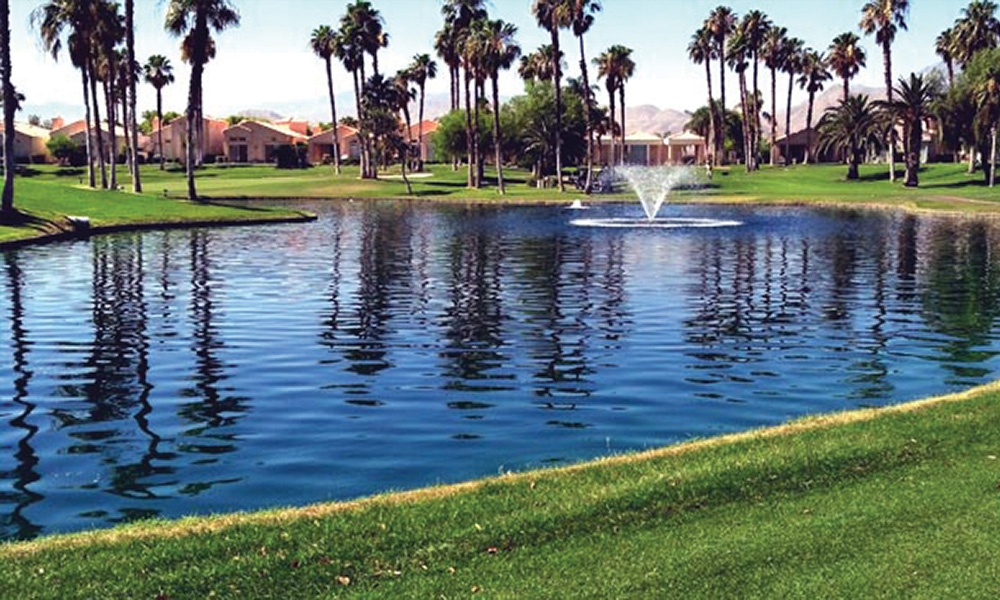Don’t Tell Me Muck Removal Isn’t Sexy!


After Golf Course Fountain installed
What do fish get on math tests? A sea plus. What do you get from neglected or mismanaged sediment removal? Future headaches. Now, just ask some Koi, snails, frogs, ducks, minnows, sticklebacks, or any romantic aquatic critters, to them, there’s nothing sexier than some fresh linens or good housekeeping to spur the old—well, I think you know what I mean, right? That’s where good smart sediment removal comes in. Likewise, it should probably go without saying —in this modern industrial age, well-maintained bodies of water require well-planned and organized sentiment governance. Trust me, very sexy stuff below the waterline.
In this short article, I’d like to present a rather rudimentary introduction and friendly call to action, in light of the critical function sediment removal plays in the health, quality, and utilization of standing bodies of water—public and private. Thereupon, the thrust here is private ponds, small lakes, and recreational facilities. Contrarily, before we continue, let me take the time to note that the following will not address the significant issues in regards to sediment removal among dams. The following is a non-industrial-based discussion. However, I’ll seize the opportunity to acknowledge that sediment removal among the over 90,000 aging dams in the United States is a costly and ongoing problem. Being a vital link in the contemporary chain of infrastructure, this writer is confident, that in time, our wonderful states and municipalities— stewards of our water supply—will come to sustainable and cost-efficient solutions to industrial sediment removal.
Related: Body of Water, or Headache


On the surface, our beautiful crystal clear lakes and lively ponds may appear healthy. However, just as a doctor’s exam or x-ray can reveal lurking health issues that simply cannot be seen in a mirror, testing the muck is the littoral forensic examination of truth. Any effort to have a decidedly healthy ecosystem must go beyond relying upon the traditional tell-tale signs of dead fish, foul odors, and/or excessive algae, et al. Sustaining the consistent grandeur of these diverse ecological communities is often a matter of preventive maintenance and the dirty little secret (pardon the pun) is testing and clearing that oozing stuff we all call “Muck.” Quick aside, “Muck” is in fact a proper scientific term for any organic matter settled at the bottom of a watery depression.
Primarily, what is muck? Well, the elementary definition can be summarized as the natural accumulation of aquatic waste from living organisms, algae, and any mixture of the decomposition of flora and fauna. A modernized amelioration to that characterization includes urban trash, toxic runoff, soil erosion, oil, and grease, etc.—all of which ghastly settle at the bottom of the water. Understand, it’s unavoidable, eventually, your water basin will have a consequential build-up of muck—even with a filter. The consequence of this aggregation being Biological Oxygen Demand (BOD). In short, the nutrients within the natural sediment, which support both plant and animal life, are smothered, to the degree in which only rooted plant life is being fed. The result, among other things, is a reduced amount of oxygen for fish and
amphibians and an increase in unhealthy algae growth. Unlike an aquarium—with your pond or lake, you don’t have the advantage of being able to spot any unhealthy amounts of muck growing over the substrate underneath the water. Thereupon, if it’s better to be safe than sorry – check the muck!
Copper & Algaecides: Making Informed Decisions
Before we go on, allow me to outline the common conditions upon which sediment removal becomes imperative.
- Significant loss of water volume.
- Contamination problems
- Soil tests reveal unhealthy levels of pollutants or bacteria which could cause disease.
- Excessive aquatic vegetation.
- The health of fish.
So, beyond the eye test and the smell, how do you check the muck? It’s cheap, easy, and lo-tech. A simple measurement stick. Any pole will do. A PVC pole purchased at a hardware store might be the best bet and no splinters. If you’re measuring a lake, of course, you’ll need a boat. As for a pond, walk or wade out to the center, the deepest area. Next, push the pole into the bottom of the pond, you’ll sense when you hit the muck level—then apply some extra pressure to it. At that time, fill the tube with the muck to the level at which you’ve reached (likely to be within 1-3 feet of muck). As you pull the pole back out, measure the depth of muck on it. Once you’ve had a chance to evaluate the muck, make sure you measure the water depth.
Furthermore, I highly recommend retaining a sample of the muck for an analysis on what is organic and inorganic. One last thing, lakes, and modern technology. As you know, much of the world has been made easy and digital. It’s no different when it comes to mapping lake beds, measuring sediment levels, and muck removal. From Sonar to Lidar, to depth charges—a variety of companies specialize in eco-sound algorithm technology to produce precise bathymetric maps. Within minutes, know how deep the muck is and where. Without question, it is the responsible option for tackling this problem.
Related: Taking an Offensive Position in Your Lake Maintenance Game
Don’t forget, this is sexy! Now, the Method and the Cost.
No matter how healthy your sediment level is, at some point, it’ll require maintenance, which primarily is a fixed amount of muck removal. Traditionally, ponds and lakes were drained and dredged to address sediment degradation. However, the environmental impact and a host of local regulatory requirements leave those older rugged methods rather undesirable and/or illegal. That leaves you squarely in a brave new world. Large or small body of water, this is a big messy job and the likely equation—the newfangled method in relation to cost, with the first objective being the completion of the unsavory task with the least amount of disruption to wildlife and the ecological processes of the pond or lake, itself. To the method, the following objectives—listed in no particular order—are ease, efficacy, and price tag. So what are your real-world options? They are varied, but in all honesty, they are not great. Nevertheless, relax… and let’s run the gamut with a light-hearted look at each of them—balancing price and performance.
- Rake & Shovel. Pre-Antediluvian technology. Need I say more? Thumbs up on the price. Thumbs up on the efficiency. Thumbs-down on the back surgery required post muck removal.
- Roller. A muck roller is a cousin to the Rake and Shovel. However, it’s 20th Century know how—electric and automatic. The good news is, you won’t break your back, weed growth will be curbed (excellent), and much of the muck is likely to be displaced to the water’s edges. Those are thumbs-up. However, it’s a 24/7 submerged mechanism. That’s electricity running through the water—God forbid it accidentally becomes a live wire. Not to mention, it will still require muck removal from the sides and it’s a rather expensive machine.
- Blower. A muck blower is a beautiful idea in theory—mainly theory. Underwater fans create a river water style current designed to move the muck along as nature would have intended. Maybe you already see a few design flaws with this approach. The fact of the matter is, blowers are only able to displace top layers, which eventually resettle. Altogether, a thumbs-down unless you only have six inches of muck.
- Vacuum Pump. The last and best hope. Sounds enticing, doesn’t it? Just Hoover the slime away. The vacuum does just that. However, if done yourself, the actual mechanics can be backbreaking work. Luckily, there are a few companies specialized in this method of muck removal—which essentially sucks up the muck and water into a sieve-style bag. The muck is removed and the water drained back in. Thumbs-up for operation. Thumbs-down on price. It’s a pretty penny. Furthermore, if your lake or pond exceeds a certain size and standard, Federal Regulations dictate where the muck can be dumped—requiring additional cost or labor intensity. Word to the wise, be careful and know all laws ahead of time. The EPA, Fish, and Game, and a whole host of Federal and State regulatory agencies closely monitor public and private waters and have the jurisdictional power to levee massive fines for any disposal of muck not strictly adhered to by law.
Related: Water Hazard: Reimage. Reinvent. Rebuild.
As this article is about removing the muck and not compensating for it, I’ll skip mats, pellets, and aerators—all of which I highly recommend, though for different reasons than the dreaded and inevitable muck removal. As much as I lampooned the above options, depending on the amount of muck on top of your sediment, in my opinion, the only sure-fire choices are the Rake and Shovel or the Vacuum Pump.
As I mentioned, your fish and ecosystem will thank you—not in words but in happy healthy ecological reproduction. We all love our waterways and want to keep them clean and healthy for generations to come. So, it’s easy to see that indeed, muck removal is sexy, because the end result is pure beauty.
Patrick Simmsgeiger, CLM President of DWI, a lake management company, Manufacturer of F-30 Algae Control, Distributor, Service Provider & Aquatic Speaker With over 40 Years of Experience in the Field contactus@dwiwater.com
Recent Posts
EcoBunker Synthetic Revetting More Sustainable than Natural Turf*
*A recent report by the Welsh government has found that EcoBunker synthetically revetted bunkers have…
Saving money and improving practice with Rangeline
Chris Thuer CGCS, superintendent at the Bear Slide club in Indiana, says that the use…
Escondido Golf and Lake Club: A Texas Golfing Treasure that Sets the Standard for Course Maintenance
When you think of a top-tier golf course, several factors come to mind: a stunning…
GCSAA names Joshua Tapp director of environmental programs
Former EPA Region 7 acting deputy regional administrator will provide strategic direction for environmental initiatives…
Circling Raven Golf Club Set to Open April 4; Coeur d’Alene Casino Amenity Unveils New Programs, Enhancements
Coeur d’Alene Casino Resort Hotel will open Circling Raven Golf Club on April 4 (weather…
Noteefy Expands Luxury Island Resort Portfolio with Additions of Casa de Campo, Fairmont Southampton
Casa de Campo Resort & Villas in the Dominican Republic and the Fairmont Southampton in…


